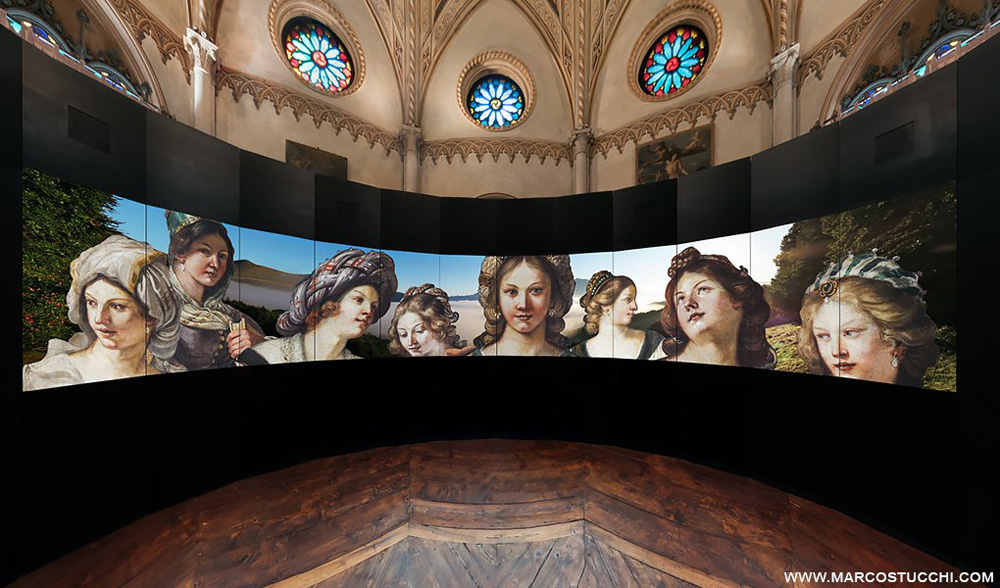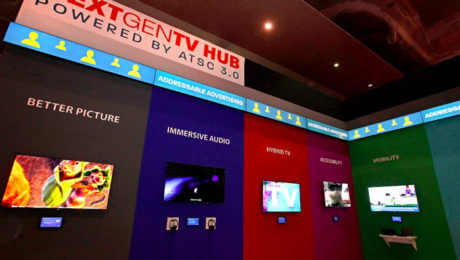
Hergiswil, Switzerland — 4 May 2017 — SpinetiX presents Guercino in Piacenza (Italy), an outstanding digital signage installation which is very engaging and culturally rich, yet presented in accessible and captivating way. Guercino in Piacenza project was created with SpinetiX Elementi software, and SpinetiX HMP350 players power 12 LG 55” screens. SpinetiX will showcase Guercino installation at stand #533 at InfoComm 2017 in Orlando.
The exhibit of Giovanni Francesco Barbieri, known as the Guercino, is featured in Piacenza. A Baroque artist born in Cento, almost four hundred years ago in 1627 accomplished one of the most significant works of his career as a painter: the magnificent cycle that decorates the dome of the Cathedral.
The city is celebrating the 17th century painter with a great event, from 4 March to 4 June 2017, unfolding in a series of initiatives that connect two symbolic places of the city, the Cathedral and the Farnese Palace, in an evocative journey that allows you to admire some of the undoubted masterworks of the artist and to discover the discrete charm of a city rich of treasures.
The visit starts at the Farnese Palace, which houses the Civic Museums, with an exhibit set in the Chapel of the Dukes. The 20 works on exhibit, with both sacred and secular themes, reconstruct the extraordinary message of the artist, offering a unique glimpse on his vast production, especially in relation to the great entrepreneurial stage of Piacenza.
The visit moves on to the majestic Cathedral, impressive for its size and shapes. This is the focal point of the event: the great dome, decorated with frescoes of the figures of the Prophets, the Sibyls, and the Christ Child between Saint Joseph and the Virgin Mary, and other characters of his infancy. The visitors go up to the under-roof structures walking through an extraordinary and unusual itinerary in the ancient walkways along the walls of the Cathedral. In this way, the visitors reach the gallery located at about 30 meters of height, overlooking the dome, to admire the painted scenes up-close.
The ideal journey to discover the artist begins at the church’s floor level, in what is called the “upper sacristy”, an ample room with a vaulted ceiling which was chosen to house the multimedia installation: an architectural structure that welcomes the public and surrounds it with a great video wall projection about the works of Guercino.
The visitor is presented with an emotionally involving narration that features suggestive images and scientific accuracy, thanks to the latest technologies of communication. Some of the chapters in which the film is structured are the iconographic program of the scenes, the working method techniques, the times it took to paint the works: both concepts regarding methods and techniques approached in an almost intimate point of view of Guercino.
The new multimedia technologies and the images that come from it constitute in this case a precious instrument of dissemination to reach in the most impacting manner a public growing in numbers. The single images that compose and animate the film have been obtained by crossing hundreds of photographic frames, in such a way as to assure a level of resolution, detail and high definition of the frescoes that has never been reached before.
The finest and most hidden details, the most delicate nuances, are made visible to the visitors thanks to the extremely high resolution of the images, in the most rigorous respect of the chromatic tones of the frescoes. The video installation is site-specific and allows the visitor to live a dynamic immersion experience, preparing them to the ascent to the dome and to direct contact with the frescoes.
The architectural installation
Form and dimensions of the installation ideally recall the octagonal shape of the dome of the Cathedral and the geometry of the sacristy that hosts it, a prestigious setting characterized by the wooden choir stalls and the ribbed vault. The structure was designed to emphasize the strong dialogue with the architectural context: it was designed as pure volumes, well defined in shape, in respectful relationship with the historical environment surrounding it. A game of surfaces in dark tones contributes to minimize the presence of the installation: the external surfaces are in fact covered with mirrors that multiply the images of the stalls, creating a suspended atmosphere.
The entrance of the room almost suggests the entrance to another space and another time: that in which Guercino worked on the frescoes of the dome. Inside, the wall becomes polygonal and an ample sequence of screens embraces the visitors and conducts them virtually to the times of Guercino. The video wall is composed of 12 screens of large dimensions placed vertically, and becomes a sort of large window on the history of the frescoes, or more, an overlooking glimpse of the landscape of Piacenza, that with the passing of seasons marks the time of the creation of the work.
The emotion created by the up-close viewing of the frescoes, made possible by the ascent to the dome, is very strong: the challenge was to recreate or at least suggest this perception through technology and the management of the exhibiting space. This is the reason for the extreme care in determining of geometry of space and in the choice of the materials of the exhibit that determine the right atmosphere for the projection of the film, also thanks to a correct regulation of ambiance lighting. The idea to be able to reproduce the sensation to be at the center of the dome is conveyed by the presence of 12 screens and by the definition of the architectural volume. The spectator finds himself in the center of the scene and is surrounded by the images of the fresco, just as if he were suspended in midair a few centimeters from the colors and the features painted by the artist.
The screens, coordinated in a network through special instruments, reproduce and manage images of the frescoes at extremely high resolution and perfect chromatic fidelity: precise and refined details flow at full screen size and we can clearly distinguish the artist’s brush strokes. The extension of the video wall allows a noteworthy perceptive experience through the immersion in the photographic moving images of the inner spaces of the Cathedral. This is a sophisticated post-production process that transforms the 360° navigable photo frames into film, and is obtained with a large number of picture frames interconnected through specific software.
The multimedia experience: discovering the frescoes of the dome
The visitor is engaged in a sort of time travel to the times of Guercino to learn about the artistic and religious context and of the key characters that determined the arrival of the painter to Piacenza. Guercino himself is the exceptional narrator who accompanies the public along on a journey through his preparatory sketches and his inspiring ideas to trace the genesis of the frescoes. Guercino invites us to go up together with him on the scaffolding to show how a “good fresco” is painted: the spectator finds himself next to Guercino, in front of his powerful characters, represented in real scale.
The approach to the narration is based on archive documents and scientific data that emerged from the last campaign of restoration works. It also highlights strongly the point of view of the painter’s possible feelings as he faces the most challenging work of his career. The extremely high-resolution images are animated and elaborated to envelop the spectators in this journey to discover the work of art.
It is an occasion to delve into refined details which up to now was impossible to notice, since the frescoes are at a height of several meters from the ground, A vortex of glances, gestures and faces meets the visitors at the end of the projection on the choral notes of Monteverdi’s music, who was a contemporary of Guercino.
The outcome of the installation
The affluence of the public to this event has been noteworthy and it seems destined to increase: thousands have visited, and reservations arrive from all over Italy and abroad. Comments are very positive and reviews, especially on specialized press, have underlined the effectiveness of the installation, which is very suggestive, very engaging and rich in cultural contents presented in accessible and captivating terms. It is of fundamental importance to prepare the visitor to the ascent to the dome and to satisfy those visitors who, for a series of different motives, cannot face the ascent to the dome. Thanks to multimedia technology, it is still possible to experience the direct encounter with the frescoes and the stories of the painted characters.
Credits
ArtZoom - www.artzoom.it
Project
- Supervision: Manuel Ferrari
- Multimedia project, spherical images, extremely high resolution images, computer elaborations: Marco Stucchi - www.marcostucchi.com
- Architectural project; creative project, artistic direction, image elaboration, film screenplay and direction: Fernando Delmastro e Clara Distefano
- Motion graphics and post production: Space Cookies s.n.c.
- Exhibit structure design: RRR Restauri s.r.l. di Marco Petrali, in collaboration with Cesare Fiordaliso and Massimo Bassanini
- Technology partner: Voome s.r.l.
Music
- Vespers of the Blessed Virgin (1610), Claudio Monteverdi:
- Domine ad adiuvandum me, Gloria Patri et Filio.
- Performed by Concertus Musicus Wien, directors: Nikolaus Harnoncourt, Jürgen Jürgens
- La catena d‘Adone (1626), Domenico Mazzocchi and Johannes Hieronymus Kapsberger
- Prologue, performed by: Scherzi Musicali, director: Nicolas Achten,
- Musical background by JoeChip.
Sound
- Narrator: Fabio Ardu; Guercino’s voice: Roberto Mare; sound recorder: Cristian Marovino
- Recorded at: Tc Rec
- Elaboration of sketches and synopsis of the “Announcement to the Sheperds”: Giorgio Delmastro



